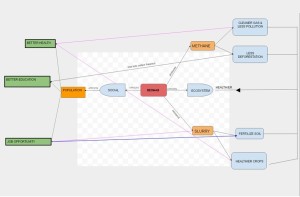The case study I chose from the provided sources involved hog farms and the environmental consequences and nuisances involved with these operations. I found this case study from the list compiled from the University of Michigan at http://www.umich.edu/~snre492/statter.html. The hog farms in question are located in North Carolina which according to this information is second in the country for hog production. The goal of the development is to produce hogs conventionally in highly concentrated systems. Also, the case study mentioned that there was a gap in the agricultural production because tobacco production has fallen off; hog production has filled this gap. It relates to the development module because these farms are filling the demand for cheap meat sources that a developed country such as the US requires. The farms seem to be located in rural areas that are less affluent, which also makes environmental justice relevant to the situation.
Also, I found a case study that looked into the treatment of agricultural workers and environmental effects from the farming systems that they work in. This study was published in Environmental Research Letters, Volume 2, Number 4, and I accessed it online at http://iopscience.iop.org/article/10.1088/1748-9326/2/4/045034/meta. These farms are located in the Valley of San Quintin in Mexico, where a large amount of fruits and vegetables are grown for export using migrant workers for labor. The living conditions are very poor for the agricultural workers, but also they are exposed to many negative environmental effects because of the area they work in. They are exposed to pesticides, respiratory contaminants, and disease. These operations are driven by the demand for produce by the US, but there is little regulation in Mexico to ensure safe conditions for the workers and people who live in these areas.
I chose these two agricultural topics because that is large part of the economy in my area in Erie County, PA. In some ways they are similar because there is environmental consequence to any agriculture. The hog situation is similar because there are nutrients that end up in the creeks and streams, however it is different because it seems like there is much more regulation here that dictates how concentrated animal operations can use manure. Also, there are not many instances where the burden of agricultural nuisances are placed disproportionately on lower income areas. There are also seasonal workers for some farms in my area which relates to the migrant workers in San Quintin. These workers also have potential to be exposed to pesticides and contaminants. The seasonal workers I am familiar with do have access to good housing and utilities unlike the Mexican workers however. I think what can be learned is that there needs to be some regulation in all of these areas. When development is only driven by economics, there tend to be injured parties. With some oversight, community involvement, and good stewardship of resources, it is possible to create more sustainable development. Geography also plays a role; the situations in case study illustrate very concentrated development, while the agriculture in northwest PA is more spread out and regulated.

